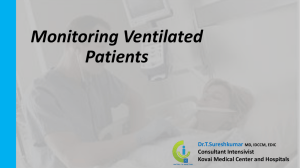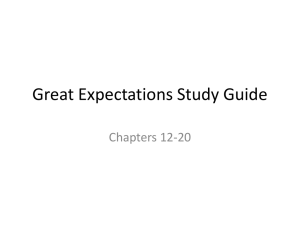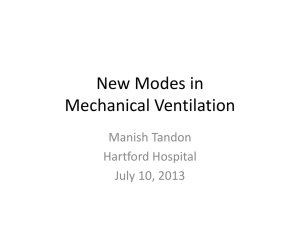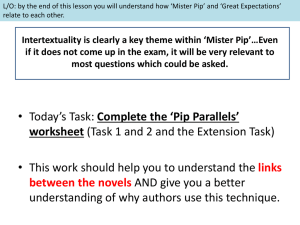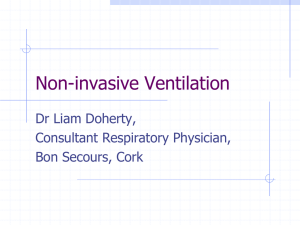Mechanical ventilation
advertisement
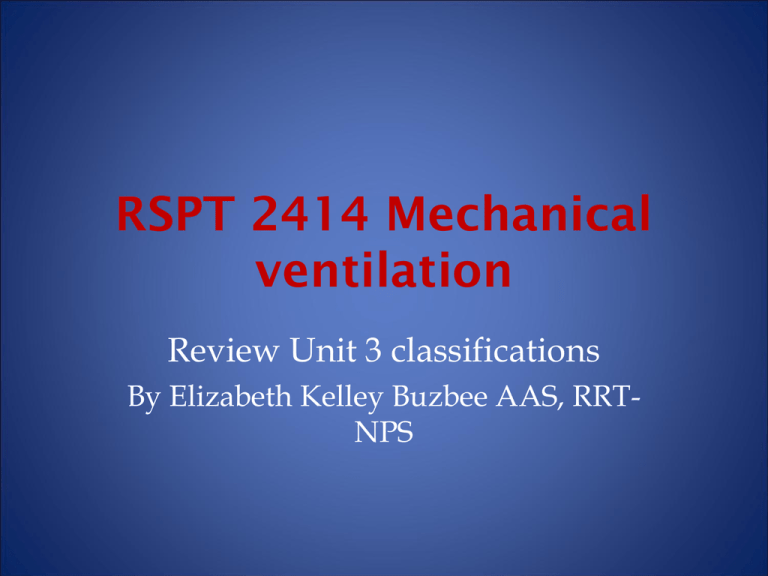
RSPT 2414 Mechanical ventilation Review Unit 3 classifications By Elizabeth Kelley Buzbee AAS, RRTNPS Question • Your patient is on a pressure control ventilation [PC]. This means: 1. The volume is constant but PIP and flows can vary with patient time constants 2. The PIP is constant, but volumes and flows can vary based on patient’s time constants 3. The flow and the VT are constant but PIP will vary based on patient’s Time constants Answer • Your patient is on a pressure control ventilation [PC]. This means: 1. The volume is constant but PIP and flows can vary with patient time constants 2. The PIP is constant, but volumes and flows can vary based on patient’s time constants 3. The flow and the VT are constant but PIP will vary based on patient’s Time constants Question • Your patient is on a volume control ventilation [VC]. This means: 1. The volume is constant but PIP and flows can vary with patient time constants 2. The PIP is constant, but volumes and flows can vary based on patient’s time constants 3. The flow and the VT are constant but PIP will vary based on patient’s Time constants Answer • Your patient is on a volume control ventilation [VC]. This means: 1. The volume is constant but PIP and flows can vary with patient time constants 2. The PIP is constant, but volumes and flows can vary based on patient’s time constants 3. The flow and the VT are constant but PIP will vary based on patient’s Time constants Question • A patient who is on pressure control ventilation will need the doctor to order what parameters to deliver a VE? 1. Respiratory frequency [f] and VT 2. Respiratory frequency [f] and PIP 3. Inspiratory time and flow rate [constant flow pattern] Answer • A patient who is on pressure control ventilation will need the doctor to order what parameters to deliver a VE. 1. Respiratory frequency [f] and VT 2. Respiratory frequency [f] and PIP 3. Inspiratory time and flow rate [constant flow pattern] Question • Your patient is on a mechanical ventilator that is gas powered. This means that the ventilator is --- powered. 1. Electrically powered 2. Battery powered 3. Pneumatically powered answer • Your patient is on a mechanical ventilator that is gas powered. This means that the ventilator is --- powered. 1. Electrically powered 2. Battery powered 3. Pneumatically powered Question • Your patient is on volume controlled ventilation. His average PIP is 20. Where do we set the high and low pressure alarms? 1. At 20 seconds 2. At 45 and 15 3. At 1.O LPM answer • Your patient is on volume controlled ventilation. His average PIP is 20. Where do we set the high and low pressure alarms? 1. At 20 seconds 2. At 45 and 15 3. At 1.O LPM question • Your patient is resting quietly on a volume controlled ventilator. His set respiratory f is 10 BPM and his total respiratory f is 10 BPM. You could assume that the phase variable that triggers each breath is: 1. Flow 2. Volume 3. Pressure 4. time Answer • Your patient is resting quietly on a volume controlled ventilator. His set respiratory f is 10 BPM and his total respiratory f is 10 BPM. You could assume that the phase variable that triggers each breath is: 1. Flow 2. Volume 3. Pressure 4. time Question • Your patient is on a volume controlled ventilator. His set respiratory f is 10 BPM and his total respiratory f is 15 BPM. You could assume that the phase variable that triggers many breathes is: 1. patient 2. manually 3. time answer • Your patient is on a volume controlled ventilator. His set respiratory f is 10 BPM and his total respiratory f is 15 BPM. You could assume that the phase variable that triggers many breathes is: 1. patient 2. manually 3. time Question • You need to hyper inflate prior to suctioning, so you push the manual breath button. This is an example of a breath that is: 1. Time triggered 2. Pressure triggered 3. Volume triggered 4. Manually triggered answer • You need to hyper inflate prior to suctioning, so you push the manual breath button. This is an example of a breath that is: 1. Time triggered 2. Pressure triggered 3. Volume triggered 4. Manually triggered question • Your patient is on volume controlled ventilation. The PIP rises to 35 cmH20 and then the pressure drops to 5 cmH20 before rising again to the PIP at the next breath. this second pressure is called: 1. CPAP 5 2. PEEP 5 3. Pressure limiting at 5 answer • Your patient is on volume controlled ventilation. The PIP rises to 35 cmH20 and then the pressure drops to 5 cmH20 before rising again to the PIP at the next breath. this second pressure is called: 1. CPAP 5 2. PEEP 5 3. Pressure limiting at 5 question • Your ventilator electrical plug is pulled out by the cleaning lady. What do you expect to happen? 1. Loss of power alarm goes off 2. Loss of pressure alarm goes off 3. Disconnect alarm goes off answer • Your ventilator electrical plug is pulled out by the cleaning lady. What do you expect to happen? 1. Loss of power alarm goes off 2. Loss of pressure alarm goes off 3. Disconnect alarm goes off question • In the event of a loss of electrical power, once the appropriate alarm goes off, what do we expect to happen next? 1. The battery will start working to keep the ventilator going 2. The high pressure alarms will go off 3. If the ventilator is plugged into emergency power source 4. Both 1 and 3 answer • In the event of a loss of electrical power, once the appropriate alarm goes off, what do we expect to happen next? 1. The battery will start working to keep the ventilator going 2. The high pressure alarms will go off 3. If the ventilator is plugged into emergency power source 4. Both 1 and 3 question • Your patient is on pressure control ventilation and the high pressure alarm goes off. What happens? 1. It will pressure cycle off 2. The breath will continue at that pressure till it is time cycled off Answer • Your patient is on pressure control ventilation and the high pressure alarm goes off. What happens? 1. It will pressure cycle off 2. The breath will continue at that pressure till it is time cycled off question • Your patient is on a volume controlled ventilator. His set respiratory f is 10 BPM and his total respiratory f is 15 BPM. You could assume that the phase variable that triggers many breathes is: 1. patient 2. manually 3. time answer • Your patient is on a volume controlled ventilator. His set respiratory f is 10 BPM and his total respiratory f is 15 BPM. You could assume that the phase variable that triggers many breathes is: 1. patient 2. manually 3. time question • Your patient is on pressure controlled ventilation and you see that the preset PIP is 35 cmH20. when the patient reaches this PIP, you will see what happen? 1. The breath will stop immediately and high pressure alarms sounds 2. Inspiration will continue at a pressure of 35 until the inspiratory time is completed answer • Your patient is on pressure controlled ventilation and you see that the preset PIP is 35 cmH20. when the patient reaches this PIP, you will see what happen? 1. The breath will stop immediately and high pressure alarms sounds 2. Inspiration will continue at a pressure of 35 until the inspiratory time is completed question • Your patient is on volume controlled ventilation; when the PIP reaches the high pressure alarm at 45 cmH20, you will see what happen? 1. The breath will stop immediately and high pressure alarms sounds 2. Inspiration will continue at a pressure of 25 until the inspiratory time is completed answer • Your patient is on volume controlled ventilation; when the PIP reaches the high pressure alarm at 45 cmH20, you will see what happen? 1. The breath will stop immediately and high pressure alarms sounds 2. Inspiration will continue at a pressure of 25 until the inspiratory time is completed question • When the breath is ended by the high pressure alarm, we say that inspiration was: 1. Pressure limited 2. Pressure cycled 3. Time cycled answer • When the breath on PC or VC is ended by the high pressure alarm, we say that inspiration was: 1. Pressure limited 2. Pressure cycled 3. Time cycled question • When the breath is ended when the patient’s preset VT of 700 is reached we stay that inspiration was: 1. Time cycled 2. Pressure cycled 3. Volume limited 4. Volume cycled Answer • When the breath is ended when the patient’s preset VT of .700 Liters is reached we stay that inspiration was: 1. Time cycled 2. Pressure cycled 3. Volume limited 4. Volume cycled question • When you see that the patient’s peak flow rate is set at 60 LPM and in a constant flow we see that the flow is always 60 LPM, we can say that this inspiration is: 1. Flow limited 2. Flow cycled answer • When you see that the patient’s peak flow rate is set at 60 LPM; and in a constant flow we see that the flow is always 60 LPM, we can say that this inspiration is: 1. Flow limited 2. Flow cycled question • When we have a volume controlled volume cycled ventilator, we expect that : 1. The PIP will be exactly the same for every breath 2. The set VT and the return VT will be very close together answer • When we have a volume controlled volume cycled ventilator, we expect that : 1. The PIP will be exactly the same for every breath 2. The set VT and the return VT will be very close together question • Your patient is on volume controlled ventilation and during a inspiratory hold we would be seeing an example of : 1. Flow limit 2. Pressure limit 3. Volume limit 4. Time limit answer • Your patient is on volume controlled ventilation and during an inspiratory hold we would be seeing an example of : 1. Flow limit 2. Pressure limit 3. Volume limit 4. Time limit question • When you see that the patient’s peak flow rate is set at 55 LPM; in a descending flow pattern that goes all the way to zero and we see that the flow never exceeds 60 LPM, we can say that this inspiration is: 1. Flow limited 2. Flow cycled answer • When you see that the patient’s peak flow rate is set at 55 LPM; in a descending flow pattern that goes all the way to zero and we see that the flow never exceeds 60 LPM, we can say that this inspiration is: 1. Flow limited 2. Flow cycled question • Your patient is on Assist/control ventilation and after the PEEP is increased you notice that the patient cannot trigger the ventilator. This implies that this patient is on: 1. Time triggering 2. Flow triggering 3. Pressure triggering answer • Your patient is on Assist/control ventilation and after the PEEP is increased you notice that the patient cannot trigger the ventilator. This implies that this patient is on: 1. Time triggering 2. Flow triggering 3. Pressure triggering question • Your patient’s average PIP is 34 cmH20. • Where do you set the alarm limits for this parameter? 1. 35 and 33 2. 32-36 3. 24 and 44 4. 20 seconds answer • Your patient’s average PIP is 34 cmH20. • Where do you set the alarm limits for this parameter? 1. 35 and 33 2. 32-36 3. 24 and 44 4. 20 seconds question • Your patient is on CPAP. His RR is 12 BPM and his average VT is .60Liters. Where do you set the VE alarm high and low limits? 1. 500 ml or .5 liters 2. 9.2 and 5.2 LPM 3. 2 and 22 answer • Your patient is on CPAP. His RR is 12 BPM and his average VT is .60Liters. Where do you set the VE alarm high and low limits? 1. 500 ml or .5 liters 2. 9.2 and 5.2 LPM 3. 2 and 22 question • Your patient is on pressure control ventilation with a PIP of 24 and a PEEP of 7. where do you set the high pressure alarm? 1. At 4 2. At 44 answer • Your patient is on pressure control ventilation with a PIP of 24 and a PEEP of 7. where do you set the high pressure alarm? 1. At 4 2. At 44 question • Your patient is on volume control ventilation. A/C 12 BPM. His average PIP is 20 and his PEEP is 5. where do you set the apnea alarm? 1. At 2 2. At 15 3. At 20 seconds answer • Your patient is on volume control ventilation. A/C 12 BPM. His average PIP is 20 and his PEEP is 5. where do you set the apnea alarm? 1. At 2 2. At 15 3. At 20 seconds question • What will happen if the low gas pressure alarm goes off? 1. The disconnect alarm goes off 2. The apnea ventilation starts 3. The machine switches to battery 4. The machine attempts to ventilate with the remaining gas. answer • What will happen if the low gas pressure alarm goes off? 1. The disconnect alarm goes off 2. The apnea ventilation starts 3. The machine switches to battery 4. The machine attempts to ventilate with the remaining gas. question • Where do you set the Fi02 alarms when your ventilator patient is on Fi02 30%? 1. 21% and 40% 2. 25% and 35% 3. 50% answers • Where do you set the Fi02 alarms when your ventilator patient is on Fi02 30%? 1. 21% and 40% 2. 25% and 35% 3. 50% question • Your patient is on pressure control ventilation. Her PIP is 25 and her PEEP is 5. Where do you set the low PEEP alarm? 1. At 15 2. At 2 answer • Your patient is on pressure control ventilation. Her PIP is 25 and her PEEP is 5. where do you set the low PEEP alarm? 1. At 15 2. At 2 question • Your patient goes apnea on CPAP. His IBW is 60kg. At what parameters should your apnea parameters be set? 1. rate 8 & VT 600 ml with Fi02 100% 2. rate 10 & VT 600 ml with Fi02 100% answer • Your patient goes apnea on CPAP. His IBW is 60kg. At what parameters should your apnea parameters be set? 1. rate 8 & VT 600 ml with Fi02 100% 2. rate 10 & VT 600 ml with Fi02 100% question • What will happen if your CPAP patient is getting apnea parameters and he starts to breath again? 1. The apnea rate drops by one breath 2. The apnea setting stop and the patient is allowed to continue with CPAP answer • What will happen if your CPAP patient is getting apnea parameters and he starts to breath again? 1. The apnea rate drops by one breath 2. The apnea setting stop and the patient is allowed to continue with CPAP question • Your patient is on volume controlled ventilation and you see that the descending flow during inspiration reaches a very low number [above zero] then suddenly drops to zero. This is an example of : 1. Flow cycling 2. Flow limiting 3. Volume cycling answer • Your patient is on volume controlled ventilation and you see that the descending flow during inspiration reaches a very low number [above zero] then suddenly drops to zero. This is an example of : 1. Flow cycling 2. Flow limiting 3. Volume cycling
